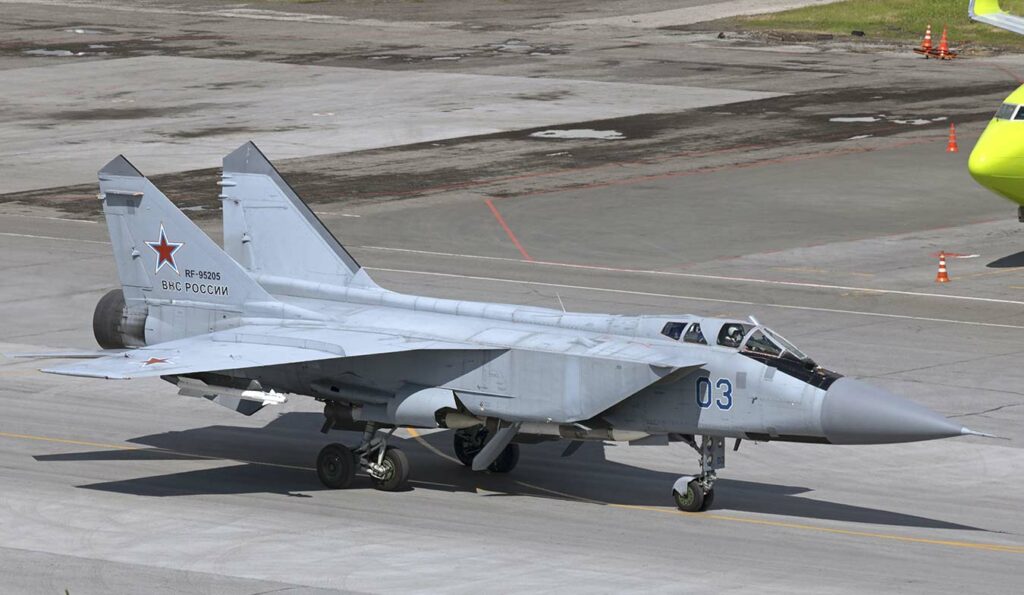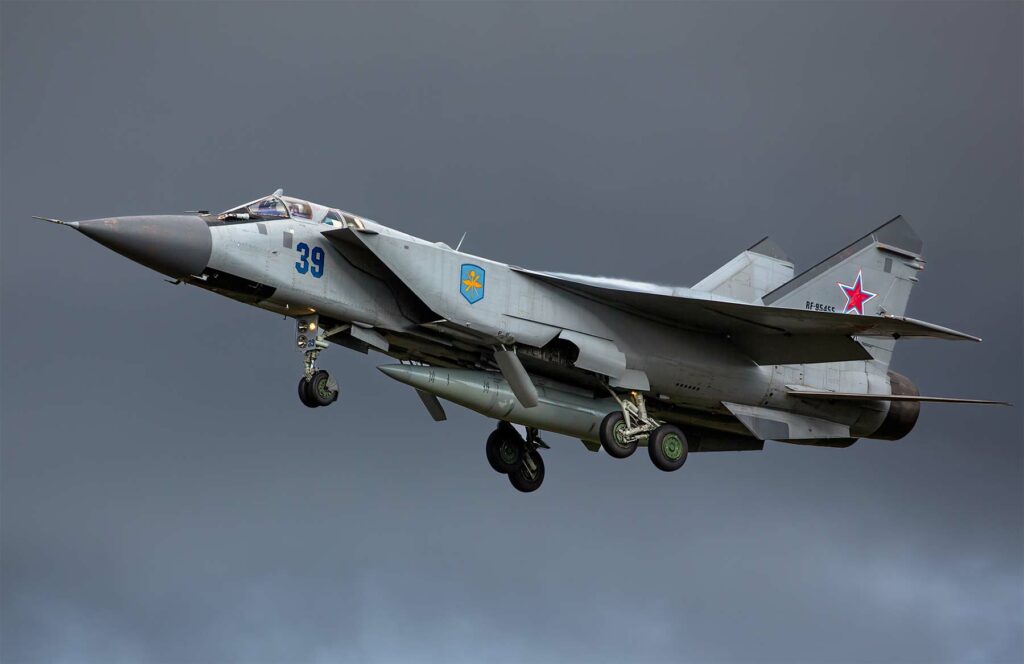Supersonic, long-range, two-seater interceptor aircraft designed for the Soviet Union’s air defense.
In brief
The MiG-31, known by NATO as the “Foxhound,” is a continuation of the MiG-25’s high-speed interceptor legacy but with significant enhancements. It features advanced digital avionics and sophisticated radar capable of detecting and engaging multiple targets at impressive distances. Powered by two Aviadvigatel D-30F6 turbofan engines, the MiG-31 achieves a maximum speed of Mach 2.83. It can operate at altitudes up to 67,600 feet with a range of 1,243 miles. Its armament includes a mix of air-to-air missiles and a 23-mm cannon, making it a formidable asset in aerial combat.

History of the Development of the Mikoyan MiG-31 Foxhound
The development of the MiG-31 began in the late 1960s as a response to advancements in Western aviation technology, particularly the need to counter high-altitude reconnaissance missions and supersonic bombers. The Soviet Union required an interceptor that could operate at extreme altitudes and speeds, leading to the MiG-31 program’s initiation. The aircraft first flew on September 16, 1975, and entered service in 1983, intended to surpass the capabilities of its predecessor, the MiG-25, with better endurance and multi-target engagement capabilities.
Design of the Mikoyan MiG-31 Foxhound
Constructed primarily from welded nickel steel, titanium, and aluminum alloys, the MiG-31’s airframe supports its high-speed interception roles. Unlike the MiG-25, its structure allows for sustained supersonic speeds at lower altitudes. The aircraft features a tandem two-seater configuration, enhancing operational capability by including a dedicated weapon systems officer. The redesign included advanced digital avionics and a powerful radar system known as Zaslon, capable of tracking multiple targets simultaneously at long ranges, a significant improvement over previous Soviet designs.
Performance of the Mikoyan MiG-31 Foxhound
The MiG-31’s performance is defined by its two D-30F6 turbofan engines, each providing significant thrust to support its high-speed interception missions. With a maximum speed of Mach 2.83 and a service ceiling of 67,600 feet, the MiG-31 can engage targets at long ranges, supported by its substantial fuel capacity and in-flight refueling capabilities. It stands out among its contemporaries for its ability to operate in all weather conditions, and its impressive electronic warfare and radar systems allow it to secure vast swathes of airspace.
Variants of the Mikoyan MiG-31 Foxhound
Several variants of the MiG-31 have been produced, each designed to enhance certain capabilities. These include the MiG-31B with improved radar and in-flight refueling; the MiG-31BM, a multirole version with upgraded avionics and weapons systems; and the MiG-31E, an export version. Specialized variants like the MiG-31D were intended for anti-satellite missions, showcasing the aircraft’s adaptability to different combat and strategic roles.

Military Use and Combat of the Mikoyan MiG-31 Foxhound
The MiG-31 Foxhound has been a pivotal asset in the air defense strategies of Russia and Kazakhstan due to its specialized design as a high-altitude interceptor. Despite not being prominently featured in combat operations, its strategic value lies in its advanced capabilities and operational roles.
High-Altitude Interception: The MiG-31 is designed to operate effectively at extreme altitudes, which is crucial for countering threats from reconnaissance aircraft and bombers flying at high altitudes. Its ability to reach and operate at altitudes up to 67,600 feet allows it to intercept aircraft that most fighters cannot reach, thus providing a unique layer of airspace security.
Patrolling Large Areas: The aircraft is equipped with the Zaslon radar system, the first of its kind with a phased array radar, which enables it to detect targets up to 200 kilometers away in a clutter-free forward sector. This long-range detection capability is critical for monitoring large expanses of territory, particularly in vast and geopolitically sensitive regions like the borders of Russia and Central Asia. The radar’s ability to track multiple targets simultaneously enhances the MiG-31’s effectiveness as a patrol interceptor, capable of monitoring and responding to multiple intrusion attempts.
Engagement Capabilities: The MiG-31 can engage intruding aircraft at significant distances, supported by its armament that includes long-range R-33 air-to-air missiles. This allows the MiG-31 to strike at targets before they come close enough to pose a direct threat to the territory it guards.
Ongoing Upgrades and Modernization: Recognizing the strategic importance of the MiG-31, both Russian and Kazakhstani air forces have invested in extensive upgrade programs to enhance its avionics, weapons systems, and radar capabilities. The upgrade to the MiG-31BM standard, for instance, has equipped the aircraft with modern multi-mode radar, improved cockpit displays, and new electronic warfare systems, substantially increasing its combat and operational capabilities.
Extending Service Life: The upgrades also focus on extending the service life of the aircraft. By updating older systems and integrating more contemporary technology, these air forces can maintain the operational readiness and effectiveness of the MiG-31 without the immediate need for replacement.
The MiG-31 Foxhound represents a critical evolution in the capability of air interceptors with its advanced radar, powerful engines, and versatile armament options. Its continued use and upgrade in Russian and Kazakhstani air forces underscore its effectiveness and enduring strategic value.
Back to the Fighter Jet section.